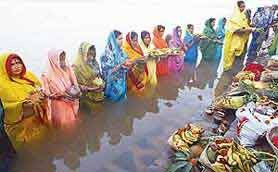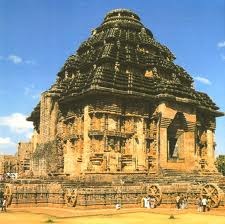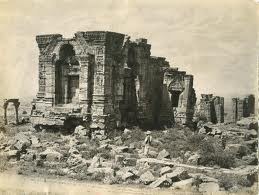V.S.Gopalakrishnan
(written on 19th Nov 2012)
Nearly 20 persons have sadly lost their lives this evening in a stampede on the banks of the Ganga river near Patna when they were doing Chhath (छठ) puja. Chhath literally means sixth, and the puja falls on the sixth day in the shukla paksha of the Karthik month. The object of worship is the sun. Mostly this is practiced by Biharis and the practice has spread over to many places in North India.
It may look curious that we still have sun worshippers and regular, traditional puja for the sun. Sun was a very important Vedic deity which came to be somewhat eclipsed by the post-Vedic and Puranic deities such as Shiva, Vishnu, Ganesh etc. The early Vedic people had occupied the territory between Afghanistan and Western Uttar Pradesh, and in course of time they moved east and occupied the Gangetic plains. And early kingdoms wielding enormous power were located in Bihar, and to recall a few they were Magadha, Mithila, Anga and Vajji. The Mauryas were Magadhans and ruled over an extensive empire. And Buddha belonged to that region, closer to Nepal. So, perhaps we can see some explanation as to how sun-worship during the Chhath Puja has been a long tradition over several centuries particularly in Bihar.
Chhath is a Prakrit word, as spoken by the common people who found it difficult to pronounce the Sanskrit equivalent Shasthi. The puja is also known as Surya Shasthi. In actual fact the rituals are spread out over four days, starting on the chaturthi and ending on the seventh day. The Puja to the Sun is for thanks-giving and for seeking continuous favours and blessing. The thanking is for sustaining life on earth and for granting wishes. The supplication is for future well-being and prosperity, not just for one-self but for all including family members and friends. And the sun is looked upon to give longevity and cure diseases, most importantly leprosy. This nature-worship would seem to have more meaning and significance than the worship of Puranic deities!
The rituals of the four day festival are rigorous. It consists of prayers, fasting, abstinence from drinking water (vratta), bathing in sacred river and standing in the river waters for hours, and offering of araghya and Prasad to the rising and the setting sun.

The festival may seem Bihar-centric historically but is celebrated also in UP, MP, Jharkhand, Chattisgarh, Delhi, Chandigarh etc. The worshippers gather on the river banks for this purpose.
There is a Mahabharata legend that when the Pandavas were in exile, once suddenly 88,000 wandering hermits came to their place and Draupadi was in a fix as to how she could cook a meal for this large contingent. She prayed to Dhaumya Rishi for help. The Rishi solved her problem considering her merits obtained by sun-worship. Draupadi’s sun-worship is said to be also the reason for the Pandavas eventually gaining their kingdom.
It is said that women outnumber men in taking part in this festival. This is the only puja for which no priest is ever called. Bihar has any number of old, small sun temples along with surajkhund (ponds).
MAJOR SUN TEMPLES IN INDIA
There are nearly eight ancient and magnificent sun temples in India. I would like to selectively pick three of them which are the most fascinating and show you how they look like:
(1) Sun temple, Konark, Orissa (below).
It is a marvelous structure built by King Narasimhadeva I of the Eastern Ganga Dynasty in the 13th century. I have visited this.

(2) Sun temple, Modhera, Gujarat (below).
It was built in 1026 AD by King Bhimdev of Solanki Dynasty. (I have not visited this)
(3) Martand temple near Anantnag, Kashmir (below, in ruins). (I have not visited this)
It is said that the foundation for this was laid around 350-500 AD. The temple was finished in the 8th Century by a King of the Karkota Dynasty. Today only the imposing ruins remain. I feel that it deserves to be rebuilt with the pieces lying around. It required one full year for the Muslim fanatic Sikandar Butshikan to destroy this temple in the 15th Century.

(all pics from Net)
===================================

No comments:
Post a Comment